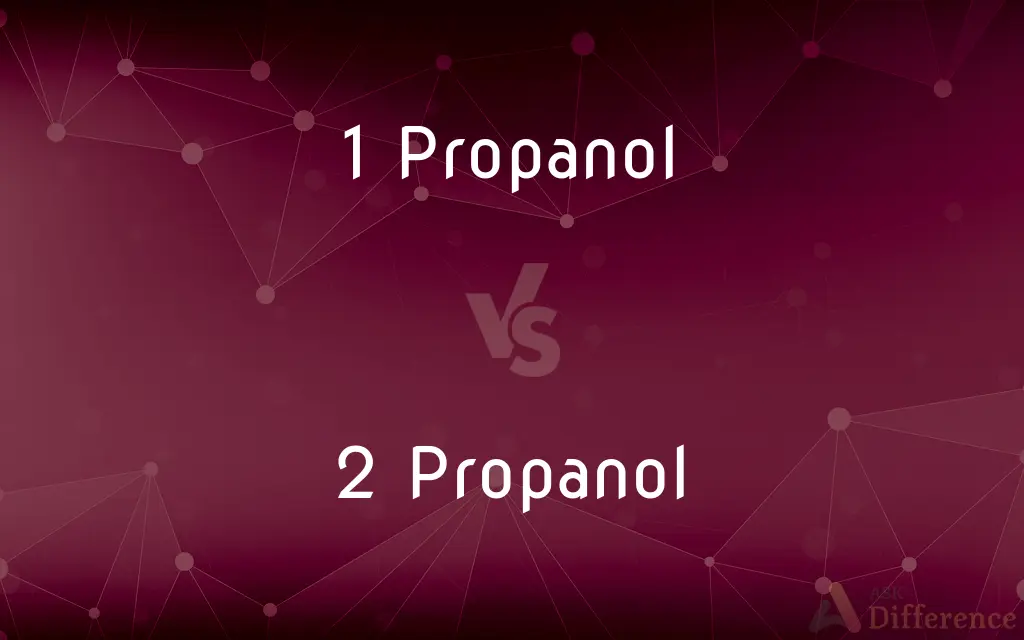1 Propanol vs. 2 Propanol — What's the Difference?
Edited by Tayyaba Rehman — By Urooj Arif — Published on September 12, 2024
1-Propanol and 2-Propanol are both alcohol compounds differing mainly in the position of the hydroxyl group, affecting their physical and chemical properties.

Difference Between 1 Propanol and 2 Propanol
Table of Contents
ADVERTISEMENT
Key Differences
1-Propanol, also known as n-propanol, is a primary alcohol with the hydroxyl group attached to the first carbon of the propane chain, whereas 2-Propanol, commonly known as isopropanol or isopropyl alcohol, is a secondary alcohol with the hydroxyl group attached to the second carbon. This structural difference influences their boiling points, solubility, and reactivity.
1-Propanol has a slightly higher boiling point than 2-Propanol due to the difference in the position of the hydroxyl group. The hydroxyl group in 1-Propanol is at the end of the chain, which allows for stronger hydrogen bonding between molecules, whereas in 2-Propanol, it is in the middle, slightly reducing the effectiveness of hydrogen bonding.
In terms of solubility, both 1-Propanol and 2-Propanol are soluble in water, but 1-Propanol's solubility is slightly lower. This is because the hydroxyl group's position affects the molecule's ability to form hydrogen bonds with water molecules. 2-Propanol, with its hydroxyl group in a more central position, can interact more effectively with water.
Regarding reactivity, 2-Propanol is more reactive in dehydrogenation reactions compared to 1-Propanol. This is because the secondary alcohol (2-Propanol) can more easily form a carbocation intermediate, making it more susceptible to reactions that lead to the formation of ketones.
Both alcohols are used in various industrial and pharmaceutical applications, but due to its effectiveness as a solvent and its antiseptic properties, 2-Propanol is more commonly used in hand sanitizers and cleaning agents. 1-Propanol is also used as a solvent but is more commonly found in the manufacture of plasticizers and as a precursor in the production of other chemicals.
ADVERTISEMENT
Both 1-Propanol and 2-Propanol are alcohols with similar molecular formulas, but their structural differences lead to variations in their boiling points, solubility, reactivity, and applications. The position of the hydroxyl group is key to these differences, with 1-Propanol having it at the end of the carbon chain and 2-Propanol in the middle.
Comparison Chart
Structural Formula
CH3CH2CH2OH
CH3CHOHCH3
Hydroxyl Group Position
Attached to the first carbon of the chain
Attached to the second carbon of the chain
Boiling Point
Slightly higher than 2-Propanol
Lower than 1-Propanol
Solubility
Slightly less soluble in water
More soluble in water
Reactivity
Less reactive in dehydrogenation reactions
More reactive in dehydrogenation reactions
Common Uses
Manufacture of plasticizers, solvent
Antiseptic, solvent, hand sanitizers
Compare with Definitions
1 Propanol
Used in the production of plasticizers.
1-Propanol acts as a feedstock for producing various esters.
2 Propanol
A secondary alcohol known as isopropanol.
2-Propanol is commonly found in hand sanitizers.
1 Propanol
Has a higher boiling point due to its structure.
1-Propanol boils at about 97°C.
2 Propanol
More volatile than 1-Propanol.
2-Propanol evaporates quickly when exposed to air.
1 Propanol
Less volatile compared to 2-Propanol.
1-Propanol evaporates more slowly.
2 Propanol
Has a lower boiling point.
2-Propanol boils at about 82°C.
1 Propanol
A primary alcohol with three carbon atoms.
1-Propanol is used as a solvent in pharmaceuticals.
2 Propanol
Widely used as a disinfectant.
2-Propanol is effective in killing bacteria and viruses on surfaces.
1 Propanol
Slightly less soluble in water.
1-Propanol mixes with water, but not as readily as 2-Propanol.
2 Propanol
More soluble in water.
2-Propanol readily mixes with water in all proportions.
1 Propanol
One of the two isometric forms of propanol; a primary alcohol with the formula CH3CH2CH2OH, formed naturally in small amounts during many fermentation processes and used as a solvent in the pharmaceutical industry mainly for resins and cellulose esters.
Common Curiosities
Are both 1-Propanol and 2-Propanol soluble in water?
Yes, both are soluble in water, but 2-Propanol is more soluble.
Are 1-Propanol and 2-Propanol interchangeable in industrial applications?
Not always, as their different properties make them suitable for different applications.
Why does 1-Propanol have a higher boiling point than 2-Propanol?
1-Propanol has a higher boiling point due to stronger hydrogen bonding between molecules.
What is the main difference between 1-Propanol and 2-Propanol?
The main difference is the position of the hydroxyl group; it's at the end of the chain in 1-Propanol and in the middle in 2-Propanol.
What is the chemical formula for 1-Propanol and 2-Propanol?
Both have the chemical formula C3H8O, but their structures differ.
Is there a difference in the smell of 1-Propanol and 2-Propanol?
Yes, there can be subtle differences in their odors due to their different molecular structures.
Can both 1-Propanol and 2-Propanol be used as disinfectants?
2-Propanol is more commonly used as a disinfectant due to its antiseptic properties.
Can 1-Propanol and 2-Propanol be used interchangeably as solvents?
While both can act as solvents, their effectiveness may vary depending on the solute and the desired outcome of the solution.
Why is 2-Propanol more reactive in dehydrogenation reactions than 1-Propanol?
2-Propanol, being a secondary alcohol, forms a more stable carbocation intermediate, making it more reactive.
What are the safety concerns associated with handling 1-Propanol and 2-Propanol?
Both are flammable liquids and can be irritating to the skin and eyes; proper safety measures should be observed.
How are 1-Propanol and 2-Propanol produced industrially?
They are produced through different chemical reactions, with 1-Propanol often derived from the hydration of propene and 2-Propanol from the hydration of propene or through the hydrogenation of acetone.
Can both 1-Propanol and 2-Propanol be found in consumer products?
Yes, both are found in various consumer products, including cosmetics, cleaning agents, and sanitizers, though 2-Propanol is more common in disinfectants.
What environmental impacts do 1-Propanol and 2-Propanol have?
Both can contribute to air and water pollution if not properly managed; however, 2-Propanol is more volatile and may have a more immediate impact on air quality.
How does the position of the hydroxyl group affect the solubility of 1-Propanol and 2-Propanol in water?
The position affects the molecule's ability to form hydrogen bonds with water, influencing its solubility.
How does the difference in hydroxyl group position between 1-Propanol and 2-Propanol affect their boiling points?
The hydroxyl group's position affects the strength of hydrogen bonding between molecules, with 1-Propanol's end-position allowing for stronger hydrogen bonds and a higher boiling point compared to 2-Propanol.
Share Your Discovery

Previous Comparison
Far Infrared vs. Near Infrared
Next Comparison
Sale Deed vs. Conveyance DeedAuthor Spotlight
Written by
Urooj ArifUrooj is a skilled content writer at Ask Difference, known for her exceptional ability to simplify complex topics into engaging and informative content. With a passion for research and a flair for clear, concise writing, she consistently delivers articles that resonate with our diverse audience.
Edited by
Tayyaba RehmanTayyaba Rehman is a distinguished writer, currently serving as a primary contributor to askdifference.com. As a researcher in semantics and etymology, Tayyaba's passion for the complexity of languages and their distinctions has found a perfect home on the platform. Tayyaba delves into the intricacies of language, distinguishing between commonly confused words and phrases, thereby providing clarity for readers worldwide.













































